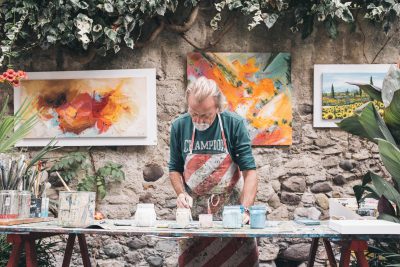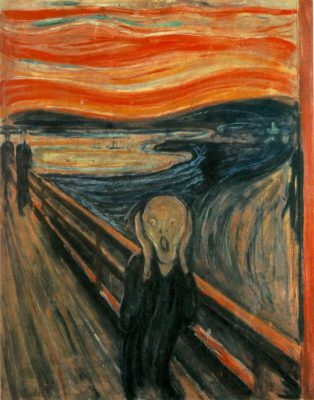Novice artisans face many difficulties as they start to design original work. Here are four of the biggest challenges, and some ways to conquer them.
Barrier #1: “I’m not the creative type.”
Many people look longingly at the beautiful creations made by master artisans. Then they sigh and say, “But I’m not a creative person, so I could never do that.”
They’re wrong.
Creativity is what you do, not what you are.
Saying “I am creative” or “I am not creative” assumes that creativity is a talent, something immutable that only a few people possess. That you can’t become creative if you aren’t already.
But creativity is much like strength: You don’t start life strong, and you don’t start out creative. You develop strength by lifting heavy things; you develop creativity by designing and making imaginative work. And anyone can do original work – even if it’s as primitive as a child’s first finger painting.
So don’t waste time wondering if you’re creative. Instead, address the much more practical questions, “What will I create? How will I create it?” Because you can develop plenty of imagination – but it won’t grow unless you exercise it.
In order to create something original, you need only three things:
- A vision of what you want to make
- Tools and materials to help you build your vision.
- Skills to forge those materials into something that satisfies your vision.
If you envision something that you have the tools, materials, and skills to make, and if you’re willing to put some time into it, then you can construct it. You don’t need to have creativity; you just need to practice creating.
But this can lead you to…
Barrier #2: The Gap
Beginners often start with a vision that is far beyond their skill to create. It’s natural to do this, especially when inspired by the work of a much more experienced artist. Then, when a project doesn’t come out as expected, a novice creator may feel that he or she has failed, and is thus “not creative”.
In truth there’s often a huge gap between vision and skill, especially at first. Ira Glass, the host/producer of This American Life, describes it this way:
Nobody tells this to people who are beginners. I wish someone had told me.
All of us who do creative work, we get into it because we have good taste. But there is this gap. For the first couple years you make stuff, it’s just not that good. It’s trying to be good, it has potential, but it’s not. But your taste, the thing that got you into the game, is still killer. And your taste is why your work disappoints you.
A lot of people never get past this phase. They quit. Most people I know who do interesting, creative work went through years of this. We know our work doesn’t have this special thing that we want it to have. We all go through this.
And if you are just starting out or you are still in this phase, you gotta know its normal and the most important thing you can do is do a lot of work. Put yourself on a deadline so that every week you will finish one story. It is only by going through a volume of work that you will close that gap, and your work will be as good as your ambitions. And I took longer to figure out how to do this than anyone I’ve ever met. It’s gonna take awhile. It’s normal to take awhile. You’ve just gotta fight your way through.”
So failure to execute exactly to your vision doesn’t mean that you’re not creative. It’s an indication that you need to develop your skills further.
Here are some ways to address The Gap.
Set an achievable goal
The first way to conquer the gap between vision and skill is to align your vision with what you can accomplish. Look at your vision and think through how you plan to build it, and where the tricky parts are. If it looks like it will be too tricky to make, scale back your vision to something that is achievable.
Every artisan does this – it’s just part of setting realistic goals. If you’re doing new work, you’ll likely reach for a vision just outside your current skill set, to provide a challenge and keep you going. But don’t reach so far you just get frustrated.
For the beginner, aligning your vision with reality can be difficult, because you don’t have any idea what’s achievable yet. In that case, you have two choices: You can set goals via trial and error, accepting that you will have some failures along the way. Or you can ask someone with more experience to help you set reachable goals. (This need not be a single person: it could be an online community, a local club or guild, a workshop teacher, or a reference book.)
Focus on learning
Another way to handle the gap between vision and skill is to make your vision a process, not a finished product. Instead of trying to make something specific, set out to learn, to explore. Pick a technique and some materials, and play around with them. Practice your technique, with variations, until a project idea occurs to you. Then follow the idea wherever it leads. The objective here is to make playful discoveries – to work improvisationally rather than trying to plan everything in advance. It’s a great way to explore what can be done, building your understanding for later work.
Barrier #3: Fear
Another common beginner’s mistake is succumbing to fear. Especially after an early failure, novice creators may plunge into despair. They feel so unsure of themselves – and so afraid of another disaster – that, faced with a new project, they can’t think of any ideas at all.
If you find yourself feeling terrified, fear not: You are not alone. Almost everyone feels nervous outside of their comfort zone, the place where you feel most competent and secure. Doing something familiar is easy – you know what you’re doing and what to expect.
But doing new things – and doing creative work always means doing new things – takes you into a scary new space where you don’t always know what to do, and where making mistakes is a very real possibility.
Overcoming fear: Just keep going
The solution is not to treat fear as the enemy, as some people will suggest. The solution is to accept your fear – and do it anyway. In Big Magic: Creative Living Beyond Fear, bestselling author Elizabeth Gilbert writes:
I even have a welcoming speech prepared for fear, which I deliver right before embarking upon any new project or big adventure. It goes something like this:
“Dearest Fear: Creativity and I are about to go on a road trip together. I understand you’ll be joining us, because you always do. I acknowledge that you believe you have an important job to do in my life, and that you take your job seriously. Apparently your job is to induce complete panic whenever I’m about to do anything interesting— and, may I say, you are superb at your job. So by all means, keep doing your job, if you feel you must. But I will also be doing my job on this road trip, which is to work hard and stay focused. And Creativity will be doing its job, which is to remain stimulating and inspiring. There’s plenty of room in this vehicle for all of us, so make yourself at home, but understand this: Creativity and I are the only ones who will be making any decisions along the way.
There is room for both fear and creativity in your life. Just make sure you know who’s in the driver’s seat.
Make friends with failure
Another way of reducing the fear of failure is to make friends with it – to fail often. If you stay in your comfort zone, your area of greatest competence, your failures will be rare and will feel humiliating, because you’re so used to being good at everything you try.
If, on the other hand, you are constantly trying new things, making mistakes, and learning from those mistakes, small failures won’t faze you and you’ll recognize them as just part of the learning process.
Barrier #4: Too Many Possibilities
Beginners often want to start with a blank page. The experienced artisan knows that a blank page is just about the worst place to start – because the infinite possibilities can quickly become overwhelming, resulting in nothing at all. Writers suffer so badly from this fear that they have become infamous for “writer’s block” – doing anything and everything to put off writing those first fateful words.
Create constraints
The quickest way to fix the paralysis of too many possibilities is to apply some constraints. Artists rightly wax poetic about artistic freedom. But too much freedom of motion can be a bad thing. In order to be effective, muscles need rigid bones to push and pull against. And a few constraints can actually spur you to greater creativity, by giving you some bones to design into your new creation.
So if you’re stuck for ideas, pick some constraints. Choose one color, one material, and one tool to feature in your work. What can you make with blue glaze, porcelain clay, and a rolling pin? Chances are those constraints instantly brought some possibilities to mind – more possibilities, in fact, than if I’d just said “Make something out of clay.”
While you don’t have to choose such drastic constraints all the time, reducing the possibilities makes it easier to come up with new ideas. In my book Master Your Craft: Strategies for Designing, Making, and Selling Artisan Work, I lay out a brainstorming exercise, “Design Poker,” in which you come up with many possible design elements (such as color, texture, and materials), putting each idea on a card. Then you draw five “idea cards” randomly from the deck. Finally, you brainstorm at least five designs in fifteen minutes, using as many of the five ideas as possible. Establishing constraints (and a time limit!), oddly, makes it much easier to get creative.
If you’ve found these tips useful, sign up for my mailing list to get notices of new blog posts, classes, and events. And please share them with your friends!





Tien, Great post. Much of this truly resonated with me. I love the “road trip” story. I will definitely keep this in mind.
Congrats on your book! I’ll be ordering one soon.
Anna Sheldon
Thanks, Anna! I’m glad you found it useful.
You really are a good writer, Tien – succinct yet evocative, a very challenging combination! Congratulations on your book (I pre-ordered via my husband for my birthday this month 🙂 and your new endeavor. I hope it exceeds your expectations!
Holly